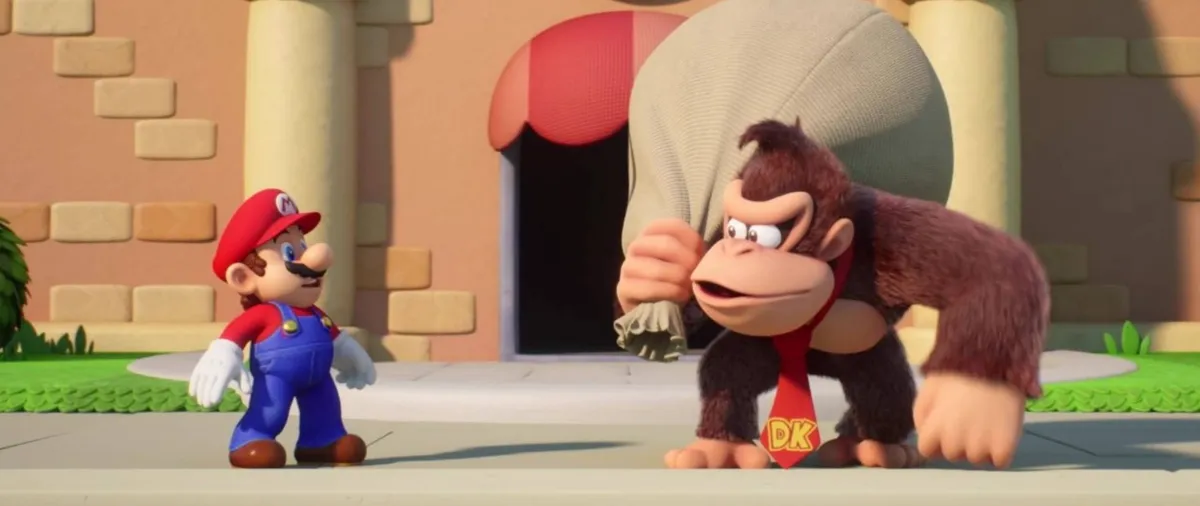A unique and engaging gameplay experience…
Introduction
“Mario vs. Donkey Kong” is a puzzle platformer developed by Nintendo Software Technology and published by Nintendo for the Game Boy Advance in 2004. This title serves as a spiritual successor to the 1994 “Donkey Kong” game for the Game Boy and takes inspiration from the classic arcade game that first introduced the rivalry between Mario and Donkey Kong. “Mario vs. Donkey Kong” combines traditional platforming elements with intricate puzzle mechanics, creating a unique gameplay experience that stands out within the Mario franchise. This review explores the game’s story, gameplay mechanics, visual and audio design, and its overall impact and reception.
Story
The story of “Mario vs. Donkey Kong” begins with a television commercial that catches Donkey Kong’s eye, advertising Mini-Marios, small wind-up toys modeled after Mario. Enthralled by the commercial, Donkey Kong breaks into the Mario Toy Company and steals all the Mini-Marios. Mario sets off on a mission to retrieve his stolen toys, leading him through various themed worlds and culminating in a series of confrontations with Donkey Kong.
The narrative is simple but effective, serving primarily to set the stage for the puzzle-centric gameplay. The humor and charm typical of the Mario series are present, with cutscenes that add a light-hearted touch to the adventure. While the story might not be deeply complex, it provides an enjoyable framework that motivates players to progress through the game.
Gameplay
Core Mechanics
“Mario vs. Donkey Kong” blends platforming with puzzle-solving in a way that requires both agility and strategic thinking. The game consists of multiple worlds, each containing a series of levels that Mario must navigate to rescue the Mini-Marios and confront Donkey Kong.
The primary objective in each level is to find the key and bring it to the locked door to progress to the next stage. Additionally, players can collect Mini-Marios scattered throughout the levels, which unlock a special stage if all are collected. The levels are filled with various obstacles, enemies, and environmental puzzles that challenge the player’s problem-solving skills and reflexes.
Controls and Mechanics
The controls in “Mario vs. Donkey Kong” are intuitive and responsive, allowing Mario to perform a variety of actions such as jumping, climbing ladders, picking up and throwing objects, and activating switches. These abilities are essential for navigating the intricate level designs and overcoming the various challenges presented.
One of the standout mechanics is the interplay between platforming and puzzle-solving. For example, players might need to manipulate conveyor belts, time their movements to avoid hazards, or use enemies as tools to reach higher platforms. The complexity of the puzzles increases as players progress through the game, introducing new mechanics and challenges that keep the gameplay fresh and engaging.
Level Design
The level design in “Mario vs. Donkey Kong” is both varied and inventive. Each world introduces new themes and mechanics, such as factory environments with conveyor belts, forest levels with vine swinging, and ice levels with slippery surfaces. The progression of difficulty is well-paced, with early levels serving as a tutorial for basic mechanics and later levels requiring more advanced strategies and precise timing.
Boss battles against Donkey Kong occur at the end of each world, providing a change of pace from the regular levels. These encounters typically involve more direct platforming challenges and pattern recognition, adding variety to the gameplay experience.
Visual and Audio Design
Visuals
“Mario vs. Donkey Kong” boasts colorful and detailed 2D graphics that are well-suited to the Game Boy Advance’s capabilities. The character sprites are expressive and well-animated, capturing the charm and personality of the Mario series. Each world has a distinct visual theme, with vibrant backgrounds and carefully designed levels that enhance the overall aesthetic appeal.
The visual design effectively balances clarity and detail, ensuring that important elements like platforms, enemies, and interactive objects are easily distinguishable. This clarity is crucial in a puzzle platformer, where understanding the environment is key to solving puzzles and progressing through levels.
Audio
The soundtrack of “Mario vs. Donkey Kong,” composed by Lawrence Schwedler, is upbeat and catchy, featuring a mix of new compositions and remixes of classic Mario tunes. The music complements the game’s whimsical and adventurous tone, adding to the overall enjoyment of the experience.
Sound effects are equally well-crafted, providing satisfying feedback for actions like jumping, collecting items, and defeating enemies. Mario’s iconic voice lines, provided by Charles Martinet, add a layer of familiarity and charm, further immersing players in the Mario universe.
Impact and Legacy
“Mario vs. Donkey Kong” received positive reviews upon its release, praised for its engaging gameplay, clever level design, and charming presentation. Critics highlighted the successful combination of platforming and puzzle-solving elements, noting that the game offered a fresh take on the traditional Mario formula.
The game’s success led to the creation of a series of sequels, each building on the foundation established by “Mario vs. Donkey Kong.” Subsequent titles, such as “Mario vs. Donkey Kong 2: March of the Minis” and “Mario vs. Donkey Kong: Mini-Land Mayhem!,” shifted focus towards the Mini-Marios and introduced new mechanics and level creation tools. This evolution of the series demonstrated the versatility of the core gameplay concepts and their appeal to a broad audience.
Criticisms and Areas for Improvement
While “Mario vs. Donkey Kong” was well-received, it was not without its criticisms. Some players found the game’s difficulty curve to be inconsistent, with certain levels presenting a significant spike in challenge that could lead to frustration. Additionally, the control scheme, while generally intuitive, occasionally felt imprecise during more complex maneuvers, impacting the overall fluidity of the gameplay.
Another point of critique was the relatively short length of the game. While the levels are densely packed with content and replayability is encouraged through the collection of Mini-Marios and high scores, some players felt that the main campaign could be completed too quickly.
Despite these criticisms, “Mario vs. Donkey Kong” remains a beloved entry in the Mario franchise, appreciated for its innovative gameplay and nostalgic charm.
Conclusion
“Mario vs. Donkey Kong” successfully blends platforming and puzzle elements to create a unique and engaging gameplay experience. The game’s intuitive controls, inventive level design, and charming presentation make it a standout title on the Game Boy Advance. Its impact on the Mario franchise is evident in the series of sequels that followed, each building on the strong foundation established by the original.
For fans of the Mario series and puzzle platformers alike, “Mario vs. Donkey Kong” offers a delightful adventure that showcases the creativity and ingenuity of Nintendo’s game design. Its combination of familiar characters and innovative mechanics ensures that it remains a memorable and enjoyable game for players of all ages. Whether you’re revisiting it for nostalgia or discovering it for the first time, “Mario vs. Donkey Kong” is a classic that continues to entertain and challenge players with its timeless appeal.


